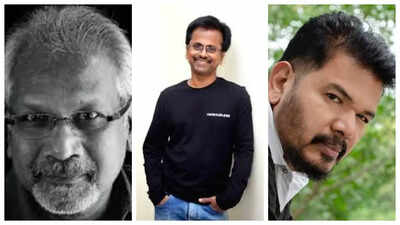ARTICLE AD BOX

In the first half of 2025, Shankar, A.R. Murugadoss, and Mani Ratnam, faced unexpected box office setbacks, despite their previous successes. 'Game Changer,' 'Sikandar,' and 'Thug Life,' failed to resonate with audiences due to dated plots, convoluted screenplays, and controversies. This highlights the evolving tastes of Indian cinema viewers, who now prioritize substance over mere spectacle and star power.
In the first half of 2025, three of Indian cinema’s most celebrated directors — Shankar, A.R. Murugadoss, and Mani Ratnam — faced rare setbacks at the box office, reminding the industry that even titans can falter.The Indian film industry thrives on its legends — directors whose names alone are enough to set the cash registers ringing. In the past, filmmakers like S. Shankar, A.R. Murugadoss, and Mani Ratnam have delivered iconic blockbusters, consistently redefining the cinematic experience for audiences across the country. But 2025 has proved to be a year of sobering realities for these stalwarts.Between ambitious projects that failed to connect and stories that felt out of touch with changing audience expectations, the first six months of this year have seen these big names deliver surprisingly underwhelming results.
Shankar’s Game Changer: A Grand Idea That Fell Flat
S. Shankar’s Game Changer, a political thriller starring Ram Charan and Kiara Advani, mounted on a massive Rs 450 crore budget, the film promised Shankar’s trademark spectacle with a socially relevant theme.The film opened strong with a ₹51 crore Day 1 collection, buoyed by Ram Charan’s star power and fan frenzy. But it quickly lost steam, and within a week, the numbers plateaued alarmingly. By the end of its theatrical run, Game Changer had earned aroundRs 131 crore in India — a number far below expectations, making it a commercial letdown given its scale and cost.
Adding to the narrative, the film’s editor Shameer Muhammed in a recent interview with Kaumudy Movies, stated “I spent a year with that film. I went there for three years. It was in the last six months that I was told I would have to stay with them for another month. I had a sketch here, so I came at that time. When I was editing, the film was 7–7.5 hours long. I made it three and a half hours. After that, a new editor came in and shortened it to 2.5–3 hours.
”He also revealed that it was Shankar’s lack of professionalism that led him to exit the film, “It was a terrible experience working with Shankar for me. I went there with great excitement, but things were happening in some other world there. He would fix one date for editing, but he would turn up only after ten days. The same pattern continued for several days, and I ended up staying in Chennai for 300–350 days.”
A.R. Murugadoss’ Sikandar: A Star-Studded Misfire
Next in line was A.R. Murugadoss, who once made an earth-shattering Bollywood debut with Aamir Khan’s Ghajini in 2008. His return to big scale Hindi entertainer with Salman Khan in Sikandar was meant to be a massy action entertainer that would reignite the director’s magic touch.However, Sikandar struggled to find its footing. Despite Salman’s formidable box office pull, the film opened to lukewarm reviews and managed to collect just about Rs 110 crore in its lifetime — a modest figure by Salman’s standards and far from the Rs 200-Rs 300 crore league his films typically aim for.Critics and audiences alike pointed out Sikandar’s dated plot, predictable tropes, and lack of freshness. In an industry increasingly shifting towards nuanced narratives and new-age storytelling, Sikandar came across as a relic of an era past.
Mani Ratnam’s Thug Life: Nostalgia Couldn’t Save This One
Perhaps the most surprising stumble came from Mani Ratnam. After the towering success of his magnum opus Ponniyin Selvan: I & II, Ratnam reunited with longtime collaborator Kamal Haasan for Thug Life. Given their history and the hype surrounding the film’s ensemble cast and high-octane action, expectations were sky-high.The film opened decently with a Rs 15.5 crore Day 1 collection but struggled to sustain. By Day 9, its tally stood at just Rs 44.75 crore in India.
Factors contributing to its underperformance included an overly convoluted screenplay, erratic pacing, and a language controversy triggered by Kamal Haasan’s remarks on Kannada, which led to the film being barred from release in Karnataka — costing it several crores in potential earnings.Despite some praise for its action choreography and Kamal’s presence, Thug Life failed to replicate the magic of Ratnam’s earlier works or Haasan’s box office pull .
What makes these underwhelming runs all the more notable is that they weren’t small experimental films but high-stakes ventures with marquee stars, massive production budgets, and extensive promotions. Yet, the results reflect a sobering truth: audiences today are unforgiving of hollow spectacles and demand substance alongside scale.All three directors seemed to bank heavily on star power, elaborate set pieces, and formulaic storytelling.
While these ingredients worked wonders a decade ago, the post-pandemic Indian audience — with its exposure to diverse OTT content and global cinema — has grown more discerning.
If the first half of 2025 has proved anything, it’s that even the biggest names in Indian cinema can falter when they fail to adapt. While these three directors have nothing left to prove given their past glories, their recent missteps underline the importance of evolving with audience tastes and storytelling trends.In an era where content reigns supreme, mere spectacle and star power no longer guarantee success. And as history has shown, it’s often in the face of setbacks that great filmmakers reinvent themselves.



.png)
.png)
.png)
















 13 hours ago
4
13 hours ago
4









 English (US) ·
English (US) ·